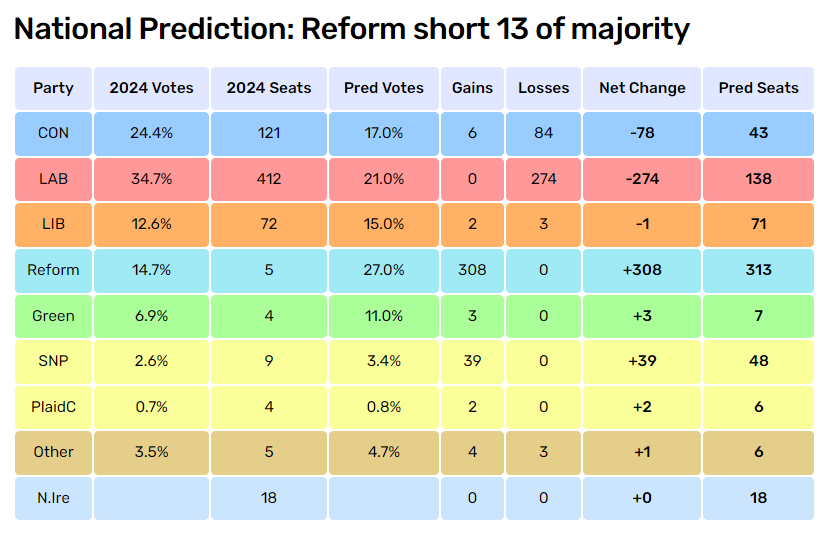Pollster: YouGov
Sample size: 2,472
Fieldwork dates: 3rd - 4th August 2025
Source
Key points
Polls seem to be stubbornly sticking still - have we settled?
Scotland’s polling is key to transforming Westminster.
Are the young still looking for something “else”?
It’s been a month’s break for me keeping up this blog so I need to apologise, but also remember exactly how much has happened since then:
The government agreed a one-in, one-out deal with France regarding illegal and irregular channel migrants.
There was the threat of a fairly significant backbench rebellion (10% of the Labour party) over changes to the welfare programme, specifically PIP.
The Online Safety Act came into force, with people being restricted from seeing porn and other vaguely-defined “violent” imagery on the internet.
Most relevant for this blog though, there has been a disruption to the polling landscape with challengers to the challengers of Reform on the right (the emergence of the non-party movement, “Restore UK”, and Ben Habib’s own Advance UK) and on the left, from the perennial Jeremy Corbyn, with Zara Sultana (though the name is TBC).
Despite all of this though… the polls have stayed stubbornly rigid. It may well be that the tumult of the last year has settled into something we might call “normal”, only in the sense that the polls could stay like this now for a few months.
Using the reliable Electoral Calculus projector, and taking advantage of YouGov polling distinctly between Scotland and England, we can see a hung parliament emerging:
The Conservatives will no doubt be hoping people like me are wrong in predicting that the polls have settled. If this result was replicated at a general election, the Conservatives would be reduced to 43 seats, less than the Scottish National Party - extinction territory. They’ve been hovering around there for a while, but this would basically confirm it.
Despite a rise in popular support, the Liberal Democrats would suffer, losing a single seat net, but that is so marginal at this stage that it’s hard to say if that would really materialise.
The headline stats are, as ever:
Reform being the largest party.
Labour’s presence being slashed to a third.
The SNP resurging to prominence in Scotland.
The potential resurgence of the SNP in Scotland is particularly important because they have been reiterating and renewing their calls or another independence referendum, amidst a cooling down of support for Reform in Scotland and a seeming four-way tie between the Tories, Labour, Reform, and Lib Dems.
Reform might be watching Wales more closely though, as Plaid Cymru seem to be coming back to strength. It’s neck and neck between them right now, though Labour are shortly behind on 23%.
It’s in England where the divide between the capital and the counties has become more stark than ever: the Greens seem to be the second-most popular party in London, where Labour dominate, and the Conservatives are clinging on to a minor, very minor lead over Reform. But out in the rest of the country, it’s the Farage show: an average of 31.5% out in the rest of England would mean the countryside and many of the major towns would fall to the turquoise wave.
We see the usual story when it comes to age brackets: Conservatives are doing best with the over 65s - though that does not mean at all that they are doing “well” - while Labour lead among the under 25s.
It’s the Greens that are particularly astounding: to be only 1% behind Labour in the under 25s is a fascinating development, and with the younger voters seemingly splitting one-third right and two-thirds left, it poses some interesting questions for the future of the country. Pay attention to that “other”, though - 7% of under 25s are looking for something else. Corbyn-Sultana’s party, maybe?
I’m finding though that the idea that Reform only doing well with old people to be a constant misnomer that never bears out with the data; they are consistently performing well across age ranges, and seem to have a solid hold over the over 50s.
And of course, there’s the question of sex; it should be no surprise by now that Reform have a solid, almost concrete lead amongst women, and a tear-away lead amongst men. Perhaps it’s also worth noting that it’s now more common for a party to have a lead amongst women than men, with the Tories, Lib Dems, and Greens having more support with women than men.
Thank you for reading this short Poll Watch post, in which I look at and discuss the most recent public opinion survey. Please consider subscribing to and sharing this blog and, if you’re feeling particularly generous, subscribing to my paid content -(detailed research and policy proposals).


